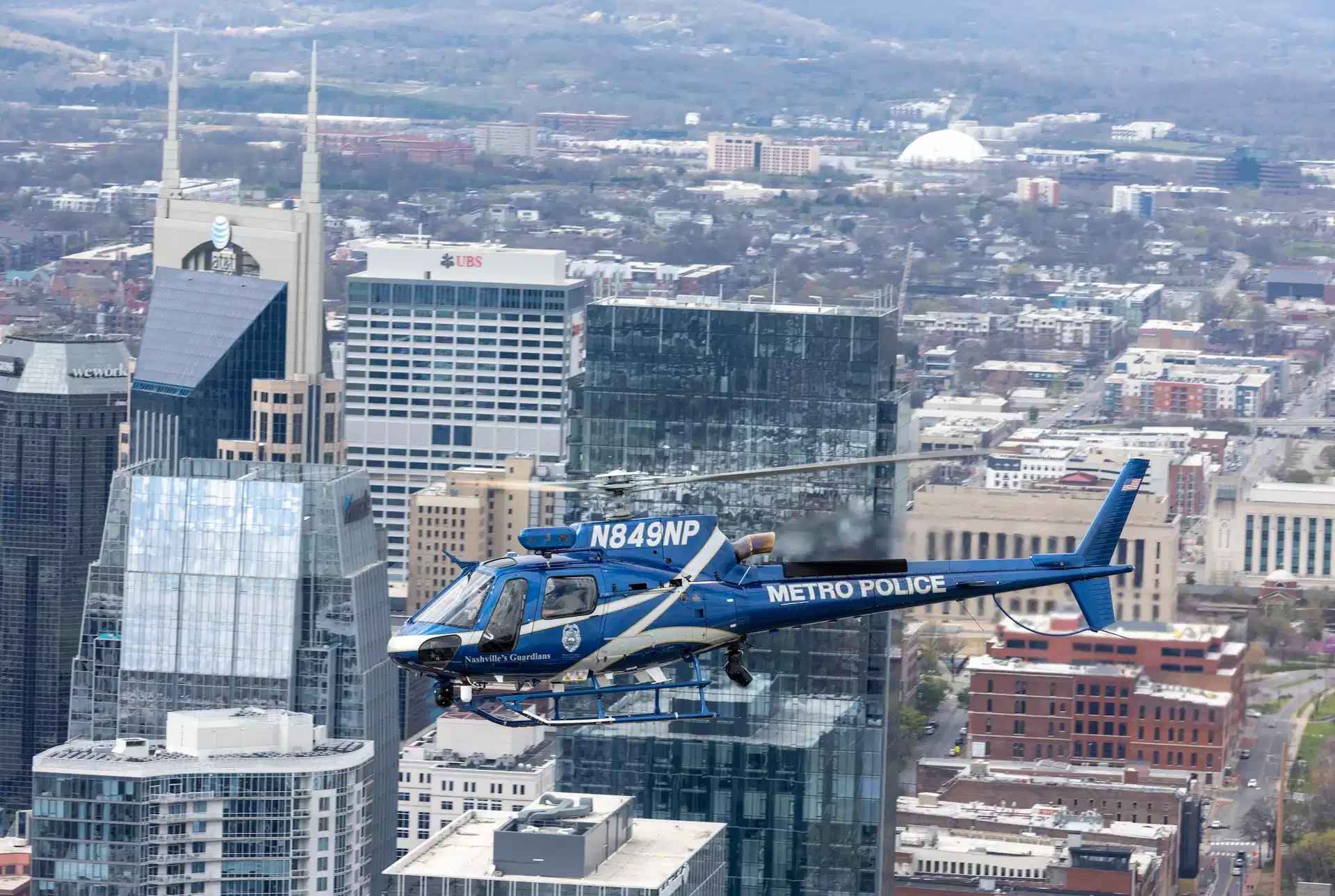Metro-Nashville Police Department Aviation recently added a pair of Airbus H125s to update its fleet of aging American helicopters. The
new aircraft and technologies are set to increase the capability and effectiveness of this long-established LEA unit that covers the 532
square miles of Davidson County.
Half a Century
The Nashville Police Department first established an aviation unit more than 50 years ago, in 1972. Its first aircraft were Bell 47s and in the 1980s the department seized a Maule fixed-wing during drug enforcement operations, then assigning that to the air unit. One or two other seized aircraft that were not assigned to the unit were also utilized on occasion and by 1989, the unit operated three Bell 47s, a Bell JetRanger and the Maule. Two new MD500Es were ordered that year and they entered service in 1990, at which time the older machines were phased out.
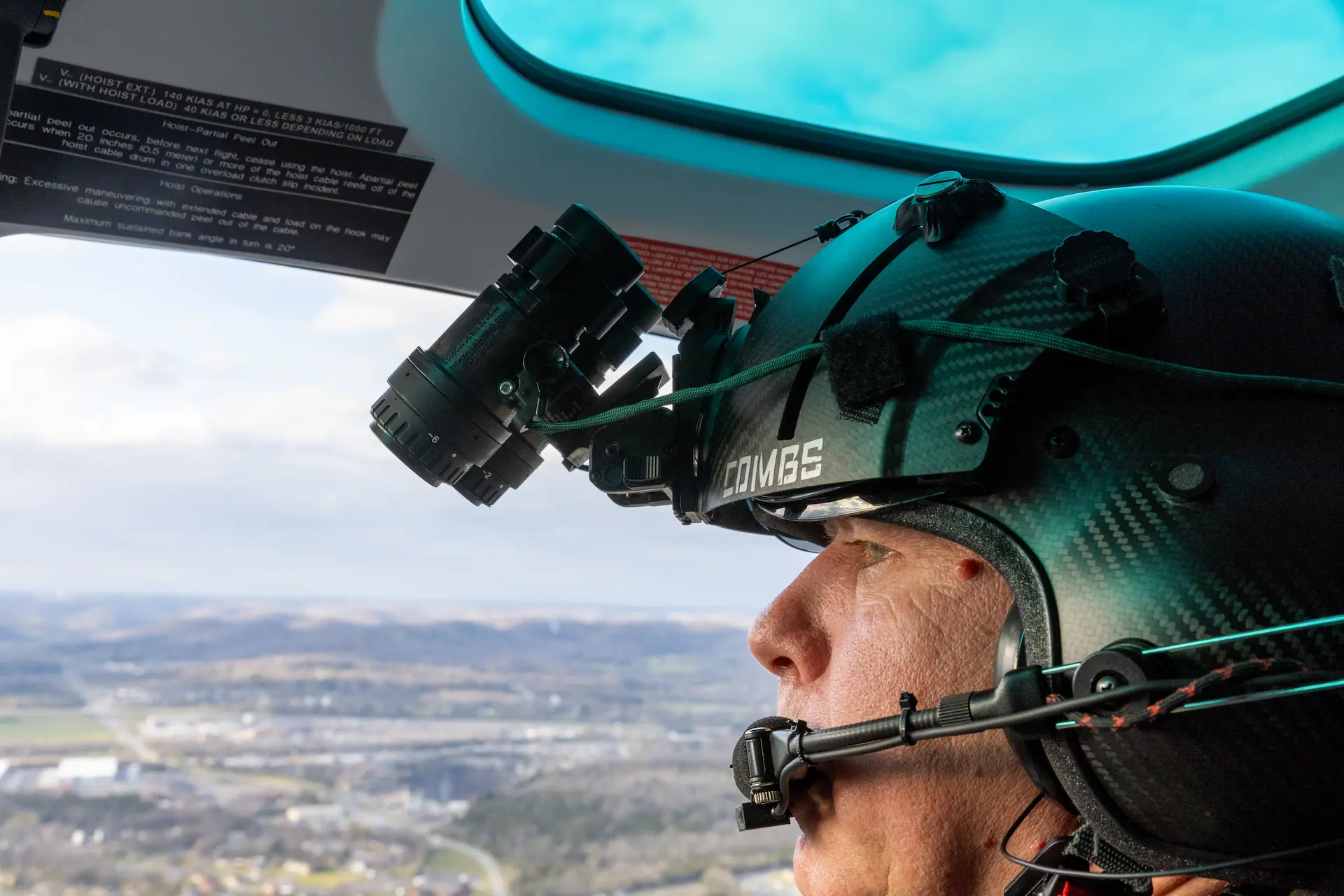
Sergeant Kurt Knapp joined the Metro-Nashville PD in 1999 after serving in the US Army’s legendary 160th SOAR (special operations aviation regiment) as a helicopter mechanic, crew chief and eventually flight engineer on Chinooks. He is currently a supervisor on the aviation unit and understandably specializes in maintenance and associated issues. He explained that one 500E was bought with drug-fund money, while the second example was taxpayer funded. “The black MD had no distinguishing markings and could only be used on drug-related calls for the first five years. We got hold of one of those old FLIR 2000s and put it on that machine for night surveillance because you didn’t have goggles and stuff back then, while the blue one bore white stripes and police markings. It looked like a police helicopter and was used for all the regular calls,” he related.
The fleet expanded significantly in 1997 with the acquisition of five ex-US Army Bell OH58s. One was retained as a parts airframe while the four that were phased into service alongside the two MD500s were refurbished and upgraded over the years. “I think they just wanted to make the unit bigger because Nashville was growing so fast, even back then in the 90s. For years now we’ve had an average of 100 people a day moving into Nashville and the population is now around a million in Davidson County.” When Knapp first arrived in Nashville, the unit had just put Garmin 500s in the 58s along with the Avalex moving map system. “Once that equipment was in them, the 58s became the workhorses of this place, especially on night shift and we really only flew the MDs on day shift. The black MD never had a mapping system, it was just a slick bird with steam gauges and the only high-tech piece in it was a Garmin 430, while the blue MD only added the Avalex mapping system,” he commented.

Getting On In Age
Because the OH58s were obtained through the government-sponsored LESO asset transfer program, they were almost free to the department, a huge benefit that outweighed the associated complexities of operating two entirely different aircraft types. The Bells boasted more headroom than the 500Es, a major advantage for night flying with goggles as the smaller MDs were not NVG compliant and also necessitated taller pilots sitting to one side when wearing goggles. The black MD eventually became the training airframe as the department trains pilots with its own in-house flight instructors, with the blue MD and Bells answering calls. This fleet served admirably for years but with the MDs hitting the thirty-year-old mark in the 2020s, it was time for their replacement. By the time they were disposed of the blue and black machines had accumulated 7,800 and 9,800 airframe hours respectively.
Knapp said that several types were considered to replace the 500s, including the MD530F, Bell 407, Airbus H125 and AgustaWestland’s AW109. The MD option was ruled out due to concerns about consistent customer service and parts supply and although MD provided a 530F for evaluation, Knapp opined that other than being new and lifting 50lbs more than the old E models, it offered no advantage over the retiring aircraft - while still posing the same space limitations for taller pilots on goggles. The unit is very pro-Bell and the 407 was initially high on the replacement wish-list, but Knapp explained that the wall in the 407’s cabin and the way the cabin tucked in created difficulties, especially for K-9 and SWAT deployments.
H125
Close scrutiny of the H125 and its spacious, flat cabin area impressed Knapp at an industry expo. “Then I spent a couple of hours talking to the Airbus maintenance people about maintenance schedules and TBOs,” he recalled. “That was really the deciding factor for us. We’d be going from the 1,750-2,000hr Rolls Royce engines in the 58s and MDs to a 5,000hr TBO on the Airbus, and that will probably eventually be extended to 6,000hrs. We also spent a lot of time talking with Texas DPS who are pretty much the gold-star Airbus operator in the country.” Knapp explained that although a smaller, less expensive type like the Bell 505 could have been selected, that would have constrained the unit’s operations to observation only, whereas the larger, more capable aircraft permitted a much broader range of mission capabilities. Floods in recent years had demonstrated that the lack of rescue capability drastically limited the unit’s ability to assist in such situations.
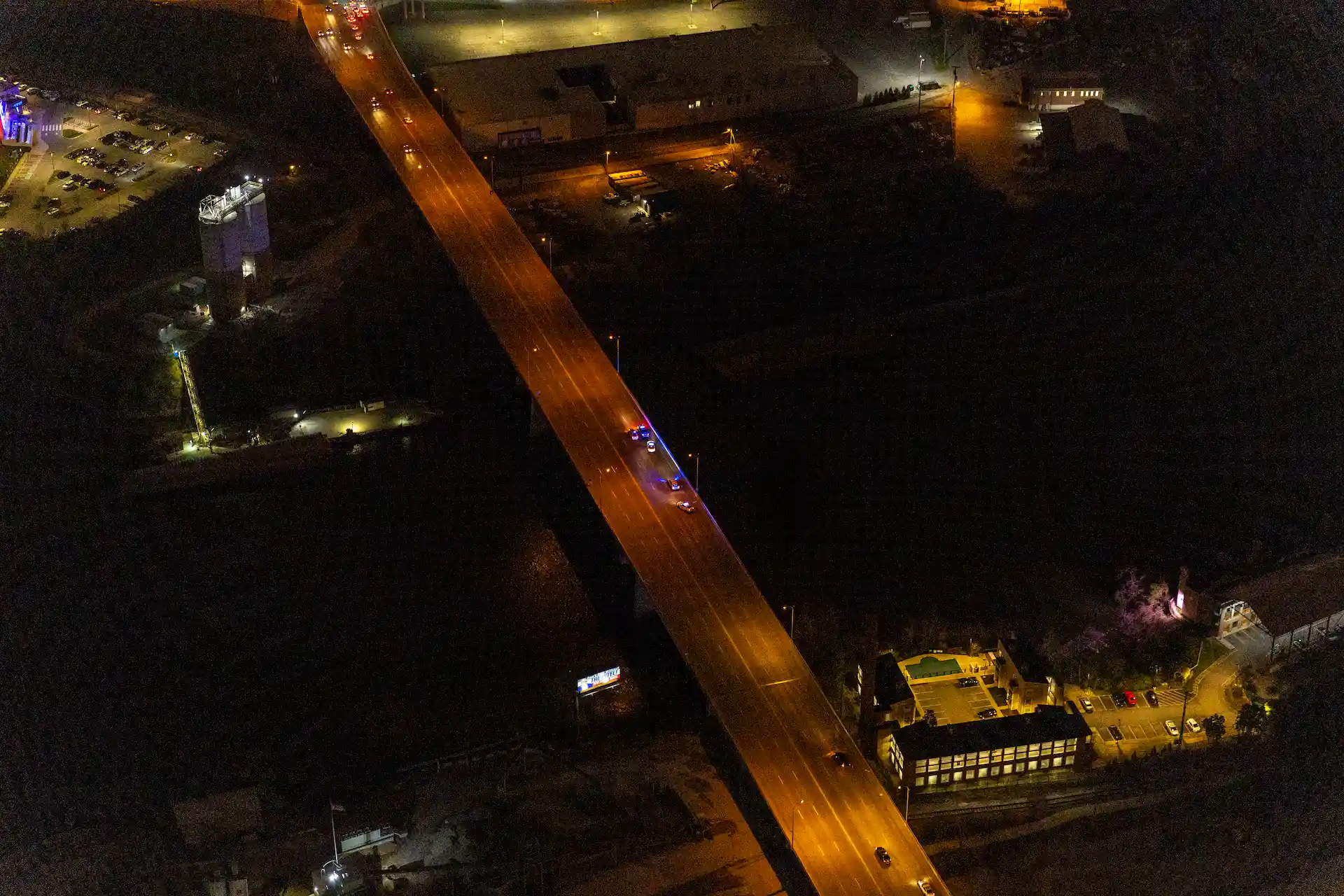
After all the foregoing factors were taken into consideration, the Airbus H125 was finally selected to replace the old 500Es and Knapp stressed, “It’s very important for me to have excellent customer service and both Bell and Airbus provide that. Macro-Blue, Summit Helicopters, Metro Aviation and Shotover are all gold-star triple-A companies and that’s why we use them. When you call them, someone always picks up the phone. We use StandardAero for engine work and it’s a bonus that they work on Turbomeca as well as Rolls Royce stuff, so they can do all our work and we don’t have to use different companies for the different types.” Moving to a new type does introduce some unavoidable challenges and Knapp acknowledged that virtually everything is different on the Airbus machines. “The maintenance is different, the manuals are laid out completely differently and the operation of the aircraft is different.” “It just takes time to learn all that stuff, whereas I’m so used to the 58s after all this time with them that I can just look at them and know when something’s out of place.”
As well as the two retired MDs, the unit released two of its 58s to another county. The Unit was additionally supplied with a set of US$100,000 TSOP (Tyler special operations platform) external seats for the H125s. Knapp reported however that the H125 cabin floor is so well suited to its operations that the Tyler seats have not yet been required. He pointed out that the advantage of operating from the open cabin door rather than the TSOP is that once the personnel are back inside with the doors closed, there is no reduced Vne limit. A hoist was deemed essential for the new machines, to increase the air unit’s capabilities for rescue work and natural disaster relief. “That’s why, if we get some TFOs assigned here permanently, we want to cross-train them so if they have to work the hoist or do aerial shooting, they can just climb in the back and they’re good to go,” Knapp advised, noting that dedicated SWAT personnel are not always available at short notice.
Working Out Well
According to Knapp, there have been no major negative aspects to the H125s and the only minor issue he acknowledged was several small ADs. It is something he described as an annoyance rather than a problem, as they can be carried out simultaneously with the routine weekly or 10-hourly ‘P’-check. “You never know what will come up in the future, but that’s true with any airframe,” he commented. Once the new aircraft had been assembled in Mississippi, they went to Metro Aviation for completion and were picked up by the unit approximately six months later. The first delivery was delayed by about a month due to a hold-up on supply of the Goodrich hoist. The first aircraft arrived in November 2022, while the second went online just after New Year 2023. Along with a hoist, Nashville’s H125s are fitted with provisions for fast-rope bars on the right side and an under-belly cargo hook. “With the hook, if we get set up with a Bambi bucket we could help at brush fires, although that’s a whole other level of training required,” Knapp said.
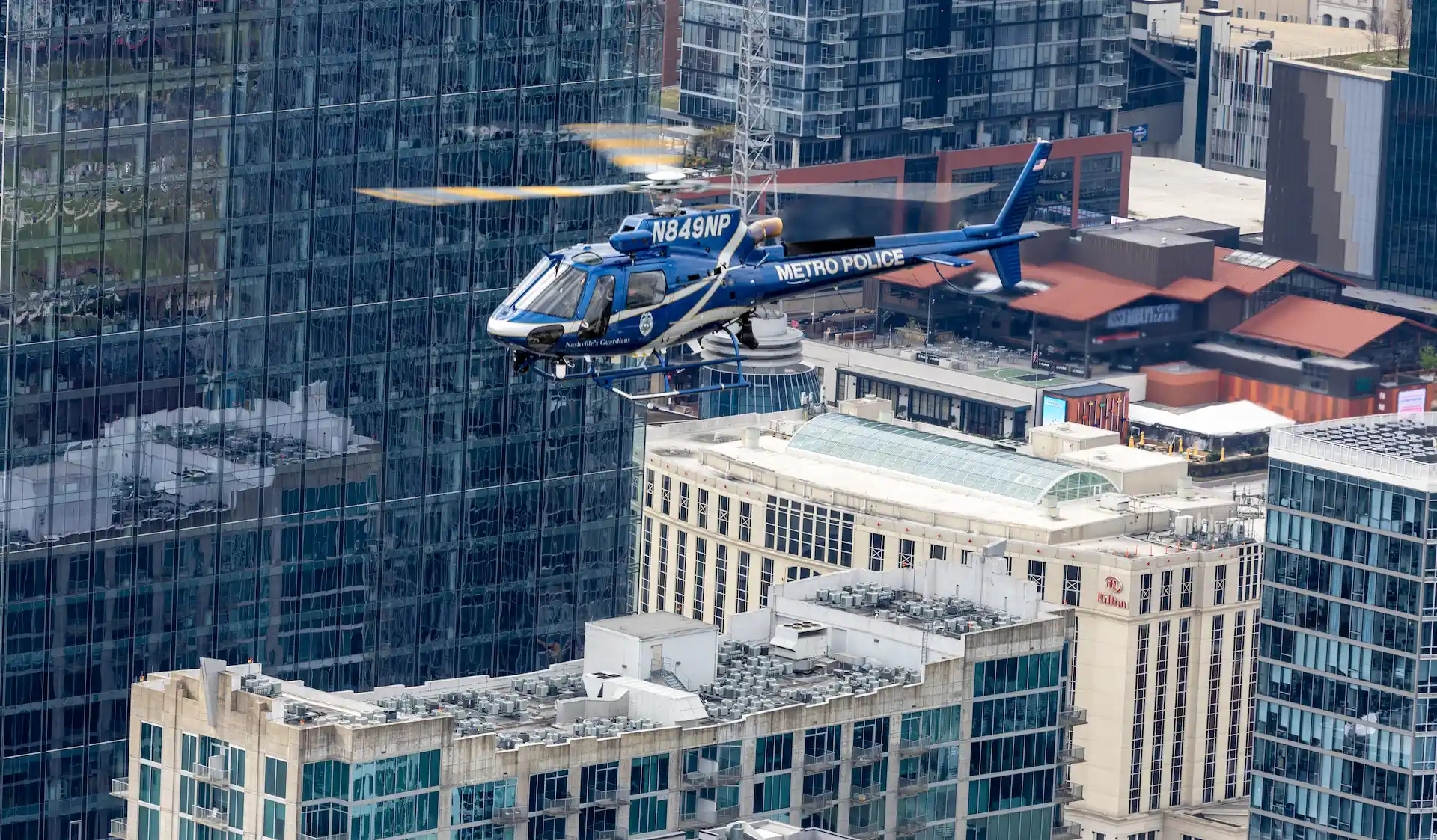
While the unit cost of approximately US$6.5 million initially sounds high, the two new H125s are identically well-equipped, with mission equipment that includes a Wescam MX-10 camera system, TrakkaBeam searchlight that incorporates multiple filters and can be slaved to the camera, RHOTHETA direction finder, Shotover Systems moving map display and a Troll real-time downlink system. “We got our first Churchill/Shotover mapping system about five years ago and it was a real game-changer. Very expensive, but it’s just super awesome. With the downlink, the state of Tennessee has put receive towers east and west of Nashville and we’re going to have one in Nashville. We all work with CNC Technologies and we hope to be able to tap into the state network so that anyone authorized can log in and access our downlinked feed, anywhere in the state. If supervisors can view a real-time feed from our cameras and map display, they can make much better, more timely decisions and everything is in HD,” Knapp noted. He commented that CNC Technologies are very good at coming out to work with Metro on systems integration and service, while the Wescam and Shotover products are able to be remotely diagnosed, corrected and updated very quickly and simply online.
Technology
The higher definition of the late-generation camera system permits operation at higher altitudes, which grants safer terrain clearance, reduced observability by suspects and minimized noise signature over communities. “In the old aircraft we’d operate at 500 to 750ft but we’re typically at 2,000 to 2,500ft in the H125 and that’s higher than the medevac helicopters that usually come buzzing in and out around 1,500ft to get fuel or whatever,” said Knapp. “What we do have to watch is the big aircraft. We’ve got Nashville International airport, and there’s John Tune that’s pretty much a relief airport that all the business jets fly into. Just outside of Nashville we have Smyrna, which is one of the busiest Class-Delta airports in Tennessee and we got all kinds of flight schools going, so the airspace can get pretty crowded.”
The H125’s fully NVG compliant aircraft and cockpit lighting make night NVG operations much less demanding, while the installed air conditioning makes flight duty far more comfortable and less fatiguing. The autopilot greatly increases safety in situations of inadvertent entry into IMC, not only levelling and stabilizing the aircraft but also able to fly a plugged-in instrument approach if necessary. Even in normal operations it eases pilot workload, which is a great benefit now that modern surveillance technology means that the TFO is working almost entirely eyes-down in the cockpit. “That means the pilot has to expand his scan and area of responsibility and the autopilot mitigates that for you by helping fly the aircraft,” Knapp observed.
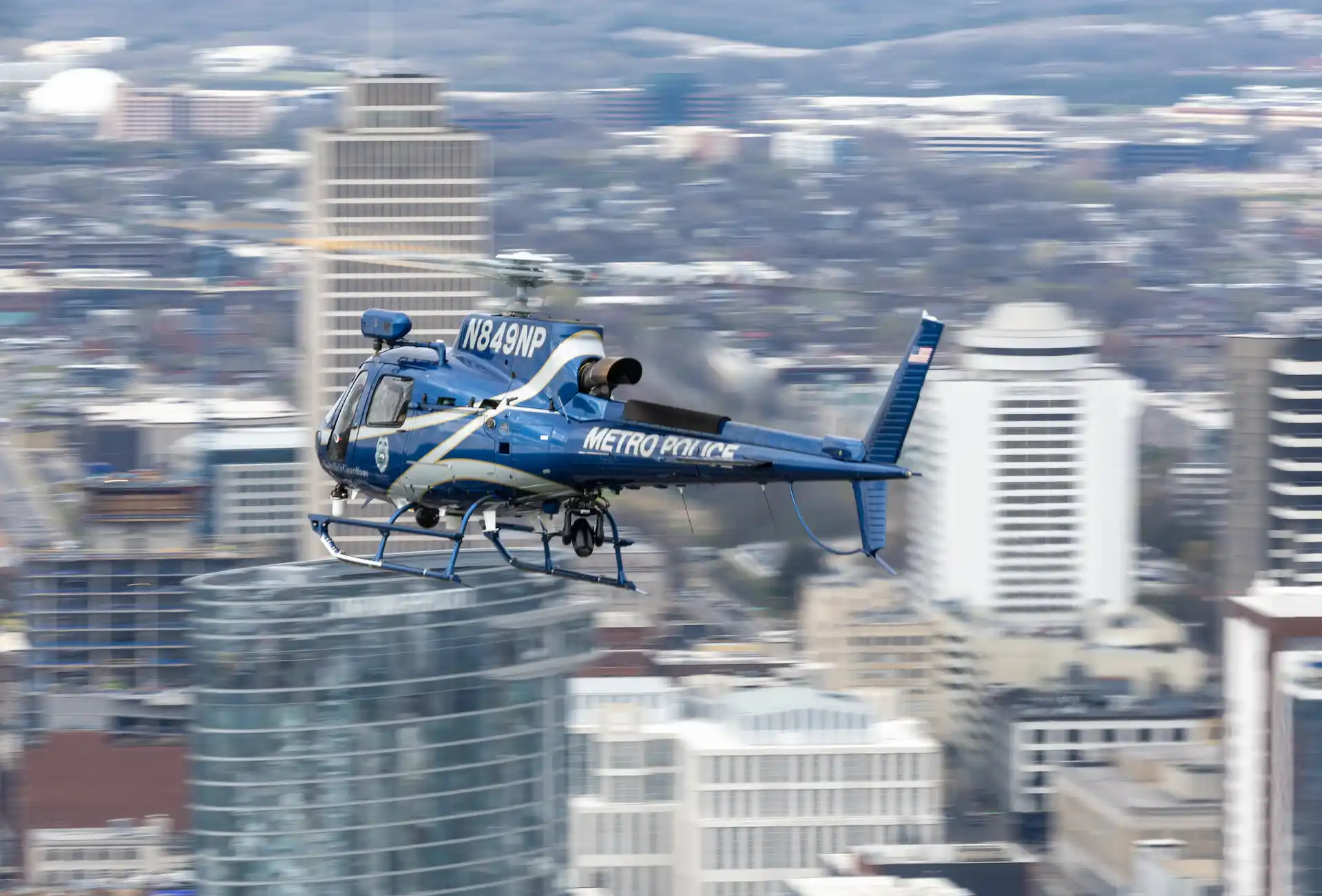
The completely glass cockpit bears no ‘steam’ gauges, running a Garmin 750 nav’ system and Garmin 650 backup, each with its own independent radios, while the display is Garmin’s new G500H-Txi with terrain, chart view and synthetic vision. Location information is aided by the ‘What Three Words’ app’ included for free with the Shotover system. Knapp explained that the app’ divides the entire globe into three-meter squares, each denoted by three specific words. “The advantage for us is that if someone is completely lost, they can just tap into the app’, give us the three words and we’ll be able to find them within three meters. Or if we see someone throw something from a moving vehicle, we can just tap the spot on the map and then come back later and find it in that three-meter square where it was dumped.”
Personnel
The pilot roster boasts six sworn and two civilian FMQ (fully mission qualified) pilots. Of the sworn, Sgt. Knapp is the first line supervisor with Sergeant Particelli supervising the TFO program. SGT Dungan, the Chief Pilot, was recently promoted in place and is now the flight operations supervisor. Lieutenant Jeff Sanders, the Tactical Operations Section supervisor, retired from the Unit on August 1st of 2023. Recently, the Unit has further expanded by four sworn officers that hold the Unit’s first full time TFO positions.
In the past, pilot positions were advertised, and the unit chose who they saw as the best candidate from the applicant pool. That process subsequently changed and to become a pilot, one now has to first serve on the unit as a full-time TFO. “That means we know them because we’ve already worked with them. Some TFO’s don’t want to be pilots but others do, and that gives us the pool to draw our new pilots from,” Knapp explained. “This is a small, tight-knit unit so it’s important to have the right people. Right now, we’re sitting pretty good.” He commented that the vetting process with the part-time TFO program has made it much easier to ensure the right people end up in the right positions.
The two civilian pilot positions were established long before Knapp joined the unit and he said that low pay rates had traditionally caused a very high turnover in those positions. Pilots became qualified on NVGs and then left to earn much more money flying medevac but now, the pay scale has become largely equivalent to medevac and he described the two current civilians as ‘dug in like Alabama ticks.’ “They’re both retired ex-160th guys, paid well, it’s fun and they’re still helping the community and doing the right thing.” Several of the sworn officer pilots also came from a military background. Previous aviation experience is not mandatory for acceptance into pilot training and the unit roster includes four qualified CFIs who can carry out in-house training from zero-time ab initio, right through to FMQ.
Knapp said that everyone is different and such factors as weather and maintenance all have a bearing on the timeframe, but that it took him fifteen months to go from Army crew-chief to air unit-trained FMQ on the OH58. Full-time K-9 officer John Gilpin is a part-time TFO with the unit, just waiting for a full-time TFO position to become available. He came to the unit with zero aviation experience but now has a PPL(H) and is about eighty percent of the way through his CPL training, the entirety of which was conducted in-house on the air unit.
Stephen Combs and Michael Hardy are the Nashville air unit’s civilian pilots, each with over twenty years of service in the Night Stalkers (160th SOAR). Combs has extensive experience on the OH58 in both the Army and Nashville PD, while instructor Hardy is a relative newbie, only joined the unit in November 2022 after flying Blackhawks in the Army. Although they joined with little or no police experience, Combs pointed out that as a special operations aviation unit, the 160th pilots were almost constantly flying in support of ground units. “It’s not much different following cars or following people from what we did in the military, it just ends differently. We’re still flying guys with guns around and the operational mentality is very similar, with everybody totally dedicated to the mission.” Although Hardy thought he wouldn’t fly again after leaving the military, he applied for the unit at the behest of Combs and now considers that he is lucky to have found a job with a positive, supportive, and professional culture and environment, and one that lets him work in Nashville.
New Type Training
Transitioning to the H125 from such an old legacy type as the OH58 makes for an interesting perspective, as Combs described. “You just can’t compare them. Not only do you have the upgrades to all the mission equipment, but then there’s such an increase in power. We have such a lot of gear hanging off it with the hoist and the FLIR ball and such, that with two or three of us in the back, we’ve still got to manage fuel quantity to keep within maximum gross weight, but it’s still got power for days! It can also fly in worse weather than the 58s so there are days when the 58s can’t fly but we can still go up in the 125.”
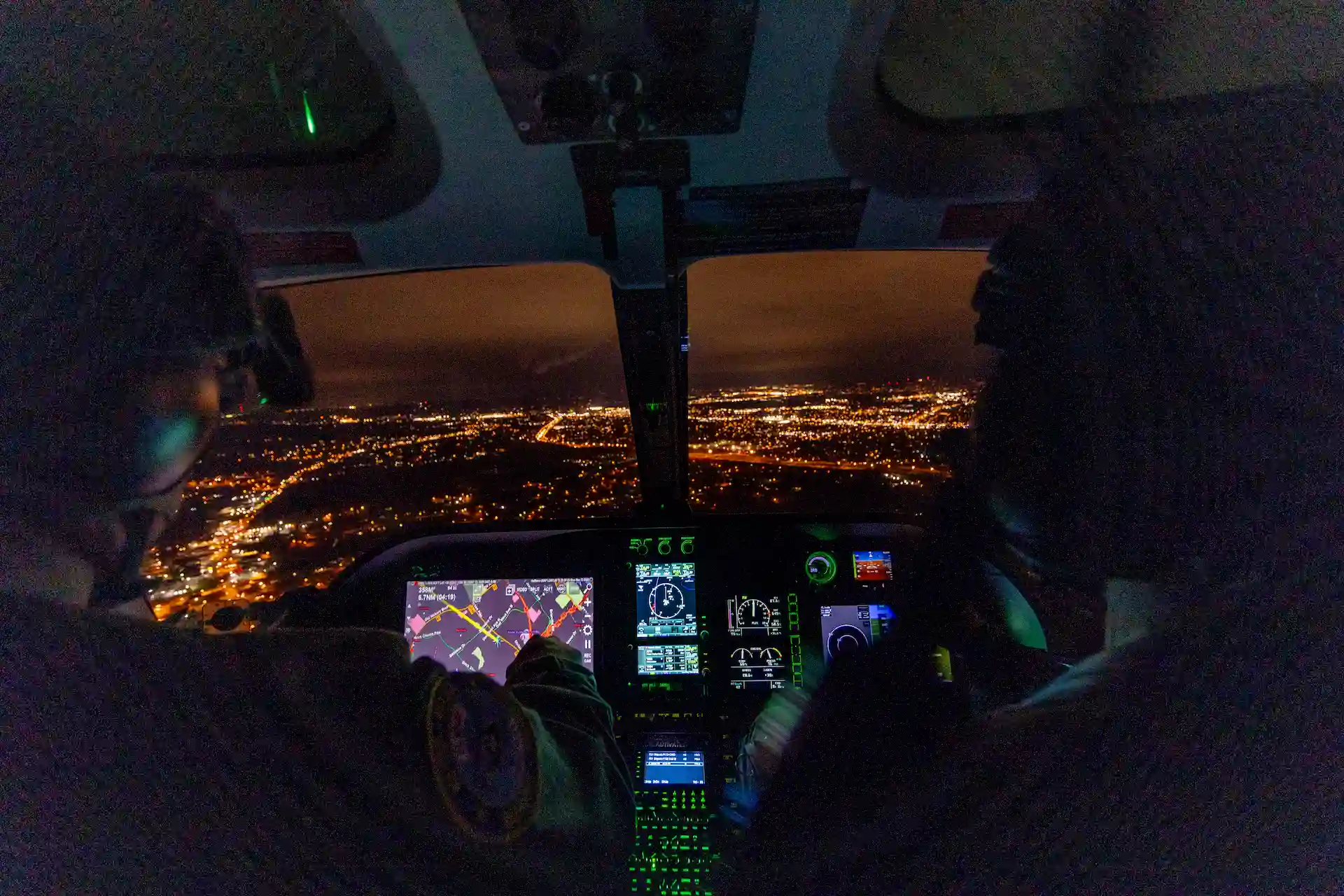
Hardy has advanced in his time and is now H125-rated and FMQ, Hardy cited the advantages the H125 brings to units on the ground as improved response and on-station times, fidelity of target imagery and communication, stating, “It’s a real game-changer after the old equipment we’ve been using until now. All the way across the board it’s going to give the guys on the ground a lot better support than the 58s could ever provide.” Combs then chipped in, commenting that the prime advantage the H125 brings is the added level of public and officer safety it provided for ground units, largely due to that vastly increased imaging fidelity and range. He added, “I think that having that high resolution imagery recorded and available for court means that those people we end up catching are going be serving longer sentences.”
The six part-time TFOs that work with the unit are all trained to fly straight and level, in order to retain control in case the pilot becomes incapacitated, and some are capable of hovering or conducting a run-on landing. They are not permanently assigned and work in a wide variety of police roles, so a second pilot will often act as the TFO. Part-time TFO numbers were cut down from eighteen after it was recognized that training demands were too high, as working just one or two days per month on the unit made it excessively difficult to maintain mission proficiency.
As permanently assigned staff numbers increase in future, it is hoped to fly crews with two TFOs so one can operate the camera and the other can act as additional eyes-out to increase situational awareness and safety. “That’s another beauty of the H125. There’s room in the back for the extra person and plenty of power, plus we have those giant windows and can see everything. When TFOs come onto the unit, the priority is to get them squared away on the camera, move them onto the hoist after that so they can do both, and then aerial shooting if we can so that they’re cross trained,” remarked Knapp. The first two weeks for a TFO are spent on dayshift, learning about the aircraft, it’s limitations and how to assist the pilot. They are introduced to the camera and simpler missions such as daytime follows, then introduced to NVGs, progress to night operations, FLIR and spotlight after passing a day exam’. “They get a little bit of everything because we want them to have a well-rounded idea of what it is that we do. By the time they are cleared to start as an active TFO they will have around twenty hours in the left-hand seat, and CRM is a major facet of our training from the very start of their TFO training,” Gilpin advised.
Two-Crew
Up until nine or ten years ago, the unit used to fly single pilot missions, something Knapp recognized as inherently unsafe and within a year or two a minimum crewing level of two up front had become standard practice. High and consistently improving safety standards have always been a unit goal and in 2019 the Nashville Police Aviation unit became one of only sixteen APSA-accredited operations in North America/Canada. The accreditation is not mandatory but demonstrates a commitment to safety on a par with such industry leaders as Texas DPS, LAPD and NYPD. The unit’s current roster is now 24 hours a day, seven days a week. He commented that the most common calls that the unit responds to are stolen vehicles, shootings and working with specialty units such as Violent Crimes Task Force. Also regular are searches for missing Alzheimer’s or dementia patients, missing children or people lost in the county’s various large park areas. The Unit recently completed hoist training with SR3 in September. All the pilot and full-time TFOs are now trained to conduct hoist operations in the H125.
Much as Knapp loves the OH58s, they are all slightly different from one another and he advised that going forward, the unit hopes to turn over its remaining examples to sister counties and replace them with a third H125 to standardize the fleet with three identical aircraft. “That depends on getting the funding approved by the Metro Council but we have a very supportive mayor and police chief at the moment. Then we should be good for another twenty years, easily,” adding that annual combined flight hours across the unit’s fleet are typically 1,500 to 2,000. “Then ideally, you’d want to trade the new machines in every seven to ten years while they’re still worth a lot of money. That’s what all the bigger agencies do. There’s always something newer and better on the latest models. The cameras you can get on their own, you just have to set aside that half-million dollars for a new Wescam. We’ve had those FLIR 8500s for more than twenty years now. They’re old technology and not as good as the MX-10s obviously but they still work, so those Wescams will probably be here long after these airframes are replaced.”
Homebase
The air unit currently works out of facilities shared with other specialist units, but funds have been approved for the construction of its own hangar and facility on John C. Tune airport. This move is slated for October of 2024. This will alleviate the issue of conflict for space in a multiple-use environment.
“Within the next year, I’d like to see us operating a third new H125, in the new hangar, with six or seven full-time TFOs and with a fixed-wing asset being funded in the fleet.” Knapp remarked. He considers his job to be a lot of fun and he enjoys being one of the good guys, chasing bad guys.
He also gains a lot of satisfaction from assisting on vehicle pursuits from which ground units have withdrawn, as the helicopter can easily maintain surveillance but the almost inevitable subsequent reduction in the pursued vehicle’s speed mitigates the risk to innocents dramatically. He concluded with the comment, “We have a really good relationship with all our ground units. It’s obviously a learning curve with the new aircraft but everyone wants us to come and play because it’s clearly
 HOME
HOME


